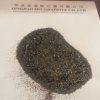Graphite is divided into natural graphite and synthetic graphite. Most people know but do not know how to distinguish them. What are the differences between them? The following editor will tell you how to distinguish between the two:
1. Crystal structure
Natural graphite: The crystal development is relatively complete, the degree of graphitization of flake graphite is more than 98%, and the degree of graphitization of natural microcrystalline graphite is usually below 93%.
Artificial graphite: The degree of crystal development depends on the raw material and the heat treatment temperature. Generally speaking, the higher the heat treatment temperature, the higher the degree of graphitization. At present, the degree of graphitization of artificial graphite produced in industry is usually less than 90%.
2. Organizational structure
Natural flake graphite: It is a single crystal with a relatively simple structure and only has crystallographic defects (such as point defects, dislocations, stacking faults, etc.), and exhibits anisotropic characteristics on the macroscopic level. The grains of natural microcrystalline graphite are small, the grains are disorderly arranged, and there are pores after the impurities are removed, showing isotropy on the macroscopic level.
Artificial graphite: It can be regarded as a multi-phase material, including graphite phase converted from carbonaceous particles such as petroleum coke or pitch coke, graphite phase converted from coal tar binder wrapped around the particles, particle accumulation or coal tar pitch. The pores formed by the binder after heat treatment, etc.
3. Physical form
Natural graphite: usually exists in the form of powder and can be used alone, but it is usually used in combination with other materials.
Artificial graphite: There are many forms, including powder, fiber and block, while artificial graphite in the narrow sense is usually block, which needs to be processed into a certain shape when used.
4. Physical and chemical properties
In terms of physical and chemical properties, natural graphite and artificial graphite have both commonalities and differences in performance. For example, both natural graphite and artificial graphite are good conductors of heat and electricity, but for graphite powders of the same purity and particle size, natural flake graphite has the best heat transfer performance and electrical conductivity, followed by natural microcrystalline graphite and artificial graphite. lowest. Graphite has good lubricity and certain plasticity. The crystal development of natural flake graphite is relatively complete, the friction coefficient is small, the lubricity is the best, and the plasticity is the highest, followed by dense crystalline graphite and cryptocrystalline graphite, followed by artificial graphite. poor.
Qingdao Furuite Graphite is mainly engaged in pure natural graphite powder, graphite paper, graphite milk and other graphite products. The company attaches great importance to credit to ensure the high quality of products. Customers are welcome to contact us.
Post time: Jul-18-2022
